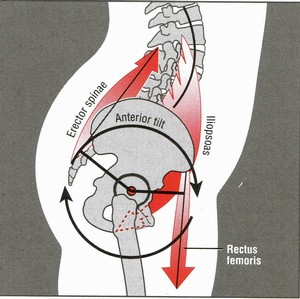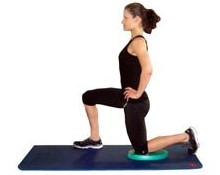Half Kneeling and Split-Stance Positions For Strength, Power and Rehabilitation
Before we dive into the post for today, I just wanted to offer a friendly reminder that today is the final day to purchase any digital product, be it Post Rehab Essentials, Muscle Imbalances Revealed: Lower Body, Muscle Imbalances Revealed: Upper Body, and have 100% of the net sales go directly to the Red Cross to help out with hurricane Sandy disaster relief efforts.
In fitness, there’s something known as functional training. Have you heard of it? The premise is simple: perform exercises that closely mimic the movements, positions and loads that will be experienced in everyday life or in sporting events. Somehow this became misconstrued to mean balancing on a bosu ball while simultaneously curling a dumbbell in one hand, playing hulahoop, and pressing an elastic with the other hand while singing jingle bells backwards in the key of “E.” Functional became so much more functional that functional forgot what functional was actually supposed to be, and the sport or activity in question became less functional than the exercise itself.
At some point, there has to be a disconnect between the new hotness of functional and what works time and again, being heavy grounded strength training. Anyone who has read this site for a while knows I’m a big advocate of ground-based strength training, and will on occasion use an unstable surface for training, but it’s rare and has to be something I can back up with research as well as a coherent thought process. That being said if I ever train someone looking to medal in the bosu olympics or who plays their sport on a field made entirely of bosu, it’s game on.
So one thing I’ve used consistently in the past is a split stance foot position for various exercises. The cool thing about a split stance position is it alters the tension on the pelvis to help someone find a neutral spine a lot easier than in a square stance, especially since most people these days tend to harvest cubicle farms and sit in a hip flexed position most of the time. This leads to bilateral changes in the hip flexors, glutes, hamstrings, and quads that make getting into neutral difficult when standing in a square stance with tension on both sides pulling the person into a classic Janda Lower Cross syndrome.
By maintaining a split stance posture, the tension on one side of the pelvis is reduced, which allows for an easier time finding neutral spine due to less resistance to the movement. I know, that was a crazy geeky thing to talk about, but it’s effective. Since everyone and their dog harps on the importance of getting to a neutral spine, I figure any posture or position that makes this cornerstone of movement easier is one to include regularly.
My e-brother Tony Gentilcore wrote a fanastic 2-part series on coaching neutral spine HERE for part 1 and HERE for part two, which I would recommend everyone check out, you know, once you’re done reading my awesomeness.
Another big benefit to half kneeling or split stance positions is that with rare exception (powerlifting, 2-foot jumping, crushing Egg McMuffins), most sporting activities are not done while predominantly in a 2 foot square stance position, but rather through an entire matrix of varied foot and hip positions. The run stride is essentially an extension of a split stance posture, which makes square stance less transferable to activities that involve running, twisting, throwing, or even most strongman events.
A major benefit for rehab and post-rehab clients is the reduction in bilateral pelvic tension, which has massive implications for those who have a history of low back troubles like yours truly. I know from experience that standing or squatting with both feet square was very difficult when I had a flare-up, but when one foot was placed forward or slightly elevated, it was heaven by comparison.
The rotational and lateral stability challenge to the core and pelvis is also a key measure of how effective the split stance and half kneeling position are. Most people find stability by holding their feet wider apart side to side, not front to back. This is great if your goal is to walk around in a crab-walk fashion all sideways and stuff, but if you want to walk or run forwards, you may have to do something different to make sure you don’t move like you’re three sheets to the wind and trying to stagger home from the bar. having a measure of lateral stability will help to improve the resiliency of the spine and core muscles so that small perturbations in rotation or lateral flexion don’t cause you to hate life for a few days.
[youtuber youtube=’http://www.youtube.com/watch?v=aVu2j7JbYgk’]
Notice the applicable use of a bosu as a knee pillow.
Now simply saying it’s awesome is a lot different from actually doing it like a boss. There are a lot of people who find the half kneeling posture is a really difficult one to get in to due to a lot of tension through the rectus femoris (quad), hip flexor, and low back, coupled with weakness from the lower abs, glutes and hamstrings to get the person into a neutral spinal posture without looking all sideways and jacked up.
The goal should be to get the hips and shoulders parallel and as close to neutral as possible, have the hips and legs in a neutral position, not stick your butt out or tuck it under, and essentially be as relaxed as possible so you don’t stop breathing. It sounds all easy and stuff, but when push comes to shove, most will need to have someone there to fine-tune their posture to get it right, or at the very least have five mirrors and an owl-like neck to check every angle out.
When in the half kneeling pose, the glute on the down leg should be active, and you should feel the quad and hip flexor of the same leg stretch lightly. If you’re tight as a drum skin, you’ll possibly feel like those muscles are being pulled off the bone and that you’re getting the most intense stretch of your life. The shoulders, hips and knee on the floor should all be vertically in line with each other.
Most people will find simply being here and maintaining neutral enough of a challenge, so doing anything additional is only necessary if they can easily do this on their own, and own the position each and every time. Once they can do this, we can progress to more fun stuff.
Since hip flexors and rectus femoris muscles are typically stupidly tight, they tend to inhibit full glute extension and firing. This means that in a half kneeling position where the hip flexors are stretched, the glute is able to contract a lot easier than if the hip was flexed. To throw a little more hate on the fire of the hip flexors, start by simply pulsing the glute to contract on and off a few dozen times and see what happens.
[youtuber youtube=’http://www.youtube.com/watch?v=-X3WWjjuDEQ’]
On a day like this where I’d already completed 25 sets of deadlifts and had another 15 to go, it would probably be beneficial to start with the bottom knee on an Airex pad or half foam roller to reduce the stretch through the quad and help get the hips in line properly. The glute should have a noticeable contraction and go through a visible shape change.
Once the pulsing is possible, keep that sucker tight and go through a split squat, making sure the glute stays fired and the movement is coming more from an extension of the back knee than a lean forward onto the front knee.
[youtuber youtube=’http://www.youtube.com/watch?v=wkyhU7U0v14′]
Once that gets easier, go with a rear foot elevated version to get a deeper stretch out of the quad and hip flexor.
[youtuber youtube=’http://www.youtube.com/watch?v=3FumVi2Nllk’]
If that’s easy, throw some weight at it.
[youtuber youtube=’http://www.youtube.com/watch?v=O_C9inuFd5E’]
Still no problem? What are you, some kind of freakin cyborg?!?!? Yeesh. If that’s the case, try some Level Change exercises, like going from a full kneeling position to a half kneeling position and then to a standing position. Here’s one such example.
[youtuber youtube=’http://www.youtube.com/watch?v=j2zZPjdjA6c’]
Check out the article in the above link to see a bunch of additional ones.
For those looking to challenge half kneeling and split stance stability, you can do that in any number of ways. As shown earlier, a Pallof variation where a cable imparts a lateral force is always a great option. Additionally, you could do a half kneeling 1-arm press using a barbell or dumbell. Props to Eric Cressey for this one.
[youtuber youtube=’http://www.youtube.com/watch?v=2RJIwiocC2I&feature=g-user-u’]
My only critique on the movement is that there isn’t nearly enough WD-40 on that machine to stop the squeaky.
A great core anti-extension exercise using a half kneeling posture is an overhead raise with a cable pulling back against your abs, like this.
[youtuber youtube=’http://www.youtube.com/watch?v=agU0yQ1kQiQ’]
So to wrap up this little training montage of a post, incorporating some half kneeling and split stance work into a workout can result in a different level of core stability challenge than a square stance could ever provide, and also help you get low back and hip issues sorted out, give some new exercises to help you stay not bored, and probably also bring back dinosaurs and help you pick up chick while they’re at it too. They’re that awesome, and you should use them as much as possible.




16 Responses to Half Kneeling and Split-Stance Positions For Strength, Power and Rehabilitation